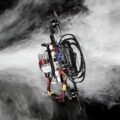The first moon landing since the final Apollo missions of the early 1970’s is expected to touch down on Earth’s lone satellite sometime early this year. If everything goes according to plan, the same NASA contractor behind the lander hopes to put a second lander down later this year as well.
BACKGROUND: MOON LANDING LOOKED LIKE IT MAY NEVER COME
When former NASA scientists Tim Crain saw the cancellation of the agency’s Constellation program in 2010, he thought that his dream of witnessing (and working on) a moon landing during his career was gone.
“I became a little bit disillusioned that the Moon was no longer an option with NASA,” Crain recently told BBC news.
Bu unexpectedly in 2018, Crain suddenly saw that his dream may not be dead after all. That’s because the moon was back on NASA’s list of objectives, with the new Commercial Lunar Payload Services project looking for private proposals to haul goods and material to the moon. Having started his own company, Intuitive Machines, with partners Steve Altemus and Kam Ghaffarian, Crain decided to submit a proposal. And they won.
Skip ahead again to 2022, and after 4 years of breakneck work and a lifetime of interest, Crain’s dream looks like it is about to come true.


ANALYSIS: FIRST SOFT LANDING IN 50 YEARS IS ONLY WEEKS AWAY
According to the Intuitive Machines website, “The first U.S. Vehicle to softly land on the lunar surface since 1972, will be our Nova-C lander. Powered by our VR900 engine, and replete with innovative avionics for advanced guidance, navigation and control, “IM-1” is capable of carrying 130kg of cargo and will ferry numerous experiments to the lunar surface by Early 2022.”
Specifically, that mission is expected to launch on a SpaceX rocket in the 1st quarter of 2022. Once it reaches a particular location, the Nova-C lander will detach from the rocket and spend four days in transit before entering the moon’s orbit. Another 24 hours or so should pass as all systems are made ready, then the lander will set down somewhere between Mare Crisium and Mare Serenitatis.
Of particular note, the lander will be using a combination of liquid oxygen and methane for fuel. This combination is not only powerful enough to do the job, but also consists of two chemical elements that should be harvestable for future astronauts and would-be moon colonists alike.
“Any place there’s carbon and water, two of the most abundant chemicals in the universe, as far as we know, we’ll be able to make methane,” said Crain. “I think that LOX (liquid oxygen) and methane is the propulsion [system] that will drive commerce through the solar system.”
OUTLOOK: GIANT STEPS ARE WHAT YOU TAKE HOPPING ON THE MOON
Assuming this first IM-1 demonstrator mission is a success, the company hopes to launch a second mission later this year, dubbed IM-2.
According to their website, “IM-2 will follow up in 2022 with our second flight, as we become the first object to land at the South Pole, use the Moon’s first ice drill, deploy our micro-Nova “hopper” – a rover to test the Nokia LTE network, and much more!”
A lot is on the line for companies like Intuitive Machines who are hoping to be part of NASAs ARTEMIS program, one which will see the space agency going back to the moon as soon as 2025. However, the imminent timing of the IM-1 launch means that we will all likely be witness to the first soft moon landing in 50 years. And given what Crain has seen throughout his career both inside and outside of NASA, he thinks this next step is only the beginning.
“I think within the next 20-30 years, you will see civilians paying for trips to the Moon, for holidays,” said Crain in the BBC interview. “Predicting the future is hard, so maybe not. But I think it’s feasible.”
Follow and connect with author Christopher Plain on Twitter: @plain_fiction
